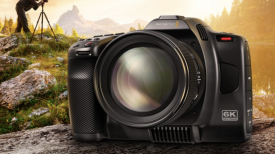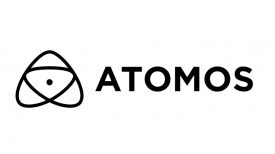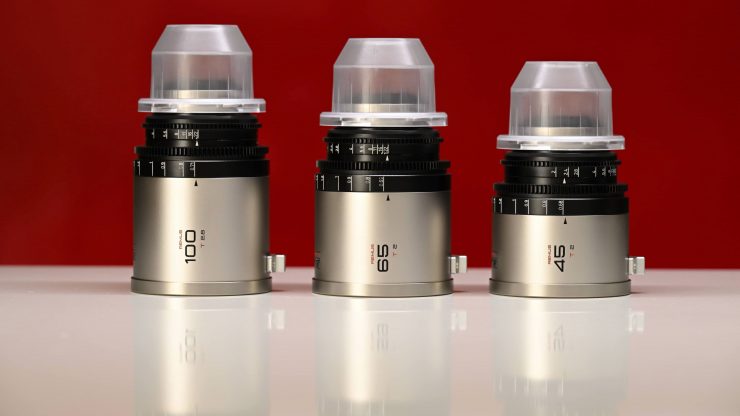
The Blazar Remus 1.5x Full Frame Anamorphic lens series consists of a 45mm T2, 65mm T2, and 100mm T2.8. The lenses are available in PL or EF mount.

The anamorphic lens market has certainly heated up over the last year or so and we now have so many options available. There are lenses with a wide array of squeeze ratios that not only cover full-frame sensors but also offer tremendous value for money.
Concept

According to Blazar, the Remus 1.5x series was designed to provide a classic anamorphic look with the added convenience of being lightweight and compact.
Blazar believes that its lenses could compete with the Atlas Mercury series in many aspects but at a lower price. That is a very bold claim indeed.
The lenses are available with either blue or amber flares depending on which option you choose.
There are currently only 3 focal lengths available, but Blazar did tell me that they will also be releasing a 35mm T2 in the future, however, for some strange reason, this lens will only cover S35 sensors. It will be interesting to see if even more focal lengths are reduced in the future.

I think it would be fair to say that Blazar is trying to attract owners of mirrorless hybrids, all the way up to owner/operators of digital cinema cameras that are capable of shooting in open-gate anamorphic modes.
Key features
- Constant 1.5X squeeze ratio
- Cover an image circle diameter of 36mm x 24mm.
- T2 Large Aperture (except the 100mm)
- Oval bokeh
- Amber & blue flare options
- Low Focus-breathing
- User-friendly cine housing
Size & Weight

The Remus 1.5x lenses are very lightweight and compact. They have the following weights:
| WEIGHT | |
| Blazar Remus 45mm T2 | 720g / 1.58 lbs |
| Blazar Remus 65mm T2 | 782g / 1.72 lbs |
| Blazar Remus 100mm T2.8 | 788g / 1.73 lbs |

The small size and weight actually surprised me when I first looked at the lenses. I thought they were going to be larger than they were. Often I would pick up the included hard case and wonder if the lenses were actually inside because it barely weighs anything.

All three lenses have fairly similar weights which is nice to see. However, in saying that, the lengths of all three lenses are different.

This low weight and compact size certainly make them suitable for use on smaller-sized digital cinema cameras or mirrorless hybrids.
So how does that weight compare to the Laowa Nanomorph 1.5x (EF/PL version) and the Atlas Mercury series? Well, below you can see:
| WEIGHT | |
| Atlas Mercury 36mm T2.2 | 1.2 kg / 2.7 lb |
| Atlas Mercury 42mm T2.2 | 1.1 kg / 2.4 lb |
| Atlas Mercury 72mm T2.2 | 1.6 kg / 3.6 lb |
| Laowa Nanomorph 27mm T2.8 | 490g / 1.08 lb |
| Laowa Nanomorph 35mm T2.4 | 520g / 1.15 lb |
| Laowa Nanomorph 50mm T2.4 | 550g / 1.21lb |
| Laowa Nanomorph 65mm T2.4 | 820g / 1.81lb |
| Laowa Nanomorph 80mm T2.4 | 830g / 1.83lb |
What you clearly need to remember is that the Laowa Nanomorph 1.5x series was only designed to cover S35+ sized sensors. While some of the focal lengths will work in certain modes with slight vignetting when recording on full frame sensor cameras, you won’t get the same coverage as you do with the Blazar Remus or Atlas Mercury series.
Atlas Lens Co. also recently announced additional focal lengths of 54mm and 95mm and 138mm in the Mercury series.
Build Quality

The Blazar Remus 1.5x anamorphic lenses are surprisingly well-made and constructed given their low price point.

They feature a quite classic and understated design. Whether or not you like the two-tone silver and black look and the clear back caps will be a personal thing.

The three-lens set comes in a nice, small hard case with custom cutouts. The lenses did not come with any shims.

What I am always looking for when it comes to sets of lenses is how consistent the mechanics and look are and this can often be a crap shoot with more affordable cine lenses. Good lenses maintain very high levels of consistency across the focal ranges. With a lot of the more ‘affordable’ lenses that I have reviewed over the years the thing that normally lets them down is consistency when it comes to the mechanics, build quality and look. If you are a lens manufacturer and want to be taken seriously by professionals then you need to be able to deliver lenses that have consistency. You also need to make sure that they are calibrated correctly, especially if you don’t include any shims.

The mechanical consistency of the Remus 1.5x lenses was a little hit-and-miss. The iris rings on all three lenses had different resistances. The 65mm and 100mm had a small grinding sound when adjusting the aperture, and the 100mm is stiffer than that of the 65mm. The aperture ring on the 45mm had the nicest resistance and smoothest movement. Look, it certainly isn’t horrible using the aperture rings on the lenses, but it is important to know exactly what you should expect.
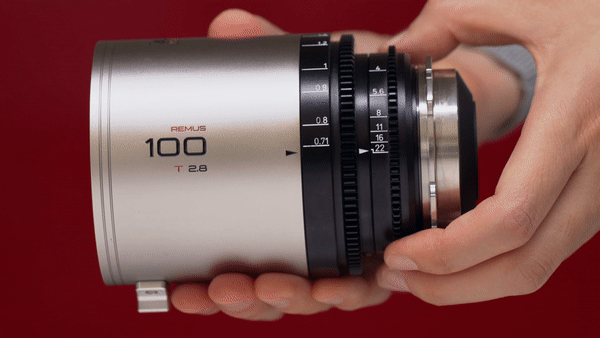
The focus resistance on the 65mm and 100m is really nice, but on the 45mm, it did make a bit of noise and wasn’t as smooth as the other lenses.

The focus rotation for all three lenses is 150 degrees, which makes it a lot easier if you are pulling focus by hand. Because the physical size of the lenses is so small, you can easily pull focus from the minimum focusing distance to infinity very easily. This certainly adds to their appeal if you are a solo operator or using smaller-sized cameras.

The focus ring on all of the lenses has hard stops that go past infinity which is nice.
Markings

Unlike a lot of lenses coming out of China, the Remus 1.5x anamorphic series doesn’t have focus markings in both feet and meters. The lenses I was testing were all in feet.

The markings are easy to see and I especially like the clear and concise focus and iris indicator mark that lets you easily see exactly what T stop or focus distance you are at.

Now, the markings aren’t perfect and on the 45mm, the aperture actually goes past T2 and it doesn’t line up correctly on T22.

On the 100mm, the aperture doesn’t line up with T2.8.

On the 65mm, the aperture ring is quite far from the T2 marking.

On the 65mm and 100mm, the markings are not consistent at T22.
Anamorphic Design

The Blazar Remus 1.5x Anamorphic Series features a front anamorphic design. This does mean that they don’t have a large rear element and you could potentially use them with speedboosters. It also means you can use them with PL mount adapters that take rear filters.
Optical Construction

All the focal lengths feature 16 aperture blades. The optical construction of the 45mm consists of 12 elements in 10 groups. The 65mm has 10 elements in 9 groups, and the 100mm has 11 elements in 9 groups.
Constant 1.5x squeeze ratio
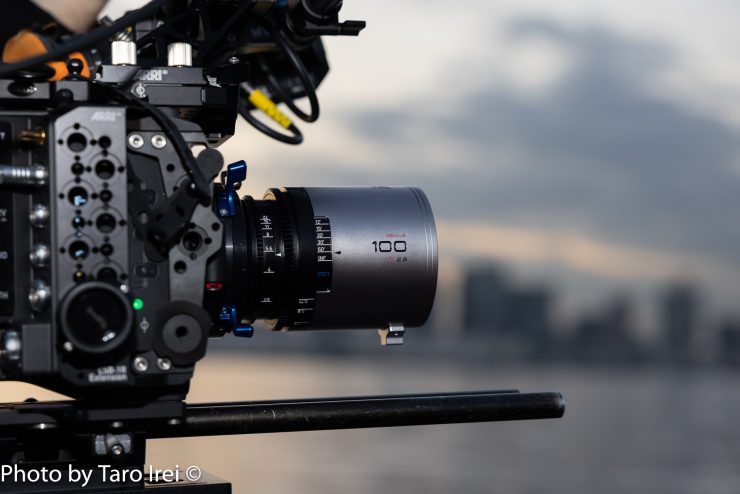
The Remus lenses create a 1.5x horizontal field with the same vertical field of view as a similar spherical lens.
Some readers may be asking why 1.5x? Well, the main reason for going with 1.5x over 1.8x and 2x is that it is more suitable for multiple delivery aspect ratios yet it also preserves a lot of the same characteristics of a 2x anamorphic including oblong oval bokeh, barrel distortion, and shallow depth of field. Keeping to 1.5x also allows the lenses to be a lot smaller and lighter than their 1.8x and 2x counterparts. The other added benefit is that they are also more affordable to the end user.
A 1.5x squeeze can produce a cinematic widescreen 2.39:1 aspect when paired up with 4:3 or 3:2 sensors. When paired up with 16:9 sensors, much less data (than 2X anamorphic lens) is needed to be cropped away to create the desired 2.39:1 ratio.
In a lot of ways, the decision to go with a 1.5x anamorphic makes a lot more sense than going with a 2x. 1.5x is more versatile and it allows the lens to be used on more cameras. Making a 1.5x anamorphic is also a lot easier than creating a 1.8x or 2x anamorphic.
Close Focus
You can see the minimum focus distance for the Remus 1.5x series below:
| Minimum Focus Distance | |
| Blazar Remus 45mm T2 | 2.23′ / 68cm |
| Blazar Remus 65mm T2 | 2.26′ / 69cm |
| Blazar Remus 100mm T2.8 | 2.32′ / 71cm |
The minimum focus distance isn’t great for the 45mm, but the 65mm and 100m allow you to capture objects that are fairly close.

If you want to focus closer then using a diopter or extension tube is probably your best bet.
How does the close focus compare to the Laowa Nanomorph and Atlas Mercury series? Below you can see:
| Minimum Focus Distance | |
| Atlas Mercury 36mm T2.2 | 1.5 ft / 46cm |
| Atlas Mercury 42mm T2.2 | 2.0 ft / 56cm |
| Atlas Mercury 72mm T2.2 | 3.0 ft / 91cm |
| Laowa Nanomorph 27mm T2.8 | 1.5′ / 43cm |
| Laowa Nanomorph 35mm T2.4 | 1′ 11″ / 60cm |
| Laowa Nanomorph 50mm T2.4 | 2′ 3″ / 70cm |
| Laowa Nanomorph 65mm T2.4 | 2′ 3″ / 70cm |
| Laowa Nanomorph 80mm T2.4 | 2′ 3″ / 70cm |
Flare Options

As I mentioned earlier, the lenses are available in either blue or amber flare color options. I would have also liked to have seen a more neutral silver option where the flare will change color according to the light source, although in saying that, I don’t think the colored flare you get is too overly pronounced in a lot of situations.
The flare produced by the lenses I was testing was, at least in my personal opinion, really nice. It isn’t overly harsh and I liked the results I was getting. The Great Joy 1.8x anamorphic lenses created some interest flares and the Remux 1.5x follow that same path. I’ll talk more about the flare further down in the review.
Other Features

All of the lenses feature unified gear positions so that they can be switched quickly between focal lengths to work with the same set of gears.

The lenses feature an 80mm outer diameter and a Ø 77mm filter thread. Having a 77mm front filter thread does make them convenient for use on mirrorless hybrids or smaller-sized digital cinema cameras that don’t feature built-in ND filters.
The lenses don’t have any back focus adjustment like you find on the Laowa Proteus 2x anamorphic series.
Why were anamorphic lenses made?
What you may not know is that anamorphosing optics was developed by Henri Chrétien during World War I to provide a wide-angle viewer for military tanks. The optical process was called Hypergonar by Chrétien and was capable of showing a field of view of 180 degrees. After the war, anamorphic lenses for cinema were originally designed so that wide format imagery would fully utilize the film area of a standard 35 mm frame. The lenses also enhanced vertical resolution and reduced the appearance of grain. The technology was first used in a cinematic context in the short film Construire un Feu in 1927 by Claude Autant-Lara. The introduction of the Super 35mm format made the difference between anamorphic and spherical lenses a lot less obvious. This is because Super 35 provided more horizontal film area, as it didn’t have to record the audio next to each frame, as was the case with standard 35mm film.
Why shoot anamorphic?

With a lot of anamorphic lenses, you are going to see image imperfections, but this is what makes anamorphic lenses so special. With modern-day cameras and sensors being so good, a lot of DPs want to try and add character through the use of vintage or/and anamorphic lenses. Image characteristics when shooting with an anamorphic lens include the bokeh taking on the appearance of being oval-shaped as opposed to circular, and flares appear as bluish horizontal or vertical streaks which can span across the entire picture. The other characteristic associated with anamorphic shooting is the widescreen aspect ratio.

If you are working in HD or 2K formats with spherical lenses, you could just crop your 2K frame to get a 2.39:1 ratio, right? Yes, you could, but the problem is you are left with just 858 lines of vertical resolution. Anamorphic lenses provide a way to capture a 2.39:1 ratio without having to make that sacrifice in resolution. Of course, you can also capture at higher resolutions (4K, 6K, 8K, etc.) and then deliver in a lower resolution as well.
Anamorphic isn’t for everyone

As the old saying goes, just because you can, doesn’t mean you should. Anamorphics aren’t for everyone and they certainly won’t be suitable for a lot of projects. The very nature of their aspect ratio makes them difficult to use for a lot of content you may want to shoot. TV broadcasters often want a native 16:9 aspect ratio as they don’t want to have black bars below and above the image shown on their viewer’s screens. A lot of DPs would love to shoot anamorphic or even in a wider aspect ratio, but this is normally vetoed by the network. Because the anamorphic-scope camera format does not preserve any of the images above and below the scope frame, it may not transfer as well to narrower aspect ratios, like the commonly used 16:9 for full-screen television.

You also need to take into account that the depth of field is also affected when shooting anamorphic-ally. Technically anamorphic and spherical lenses have the same depth of field, but in real-world use, you have to use a longer focal length with an anamorphic in order to achieve the same angle of view. This means at the same magnification (for example using a 35mm focal length), anamorphic lenses produce a shallower depth of field. As we all know, (whether you agree or not) the “cinematic” look is often associated with a shallower depth of field.
Reasons for not shooting anamorphic can include:
* Most anamorphic lenses can create artifacts or distortions
* Generally more expensive than spherical lenses
* A lot of anamorphic lenses are slower than spherical lenses and require more light
* Does not transfer well to narrower aspect ratios, such as 16:9
Sharpness
I’ll cut to the chase, the Remus 1.5x anamorphic lenses are not very sharp. As you can see from my tests, they are pretty soft when used wide open or even at T2.8. You need to use them at T4 or T5.6 if you want sharper images. If you are after sharp anamorphic lenses, then A lot of anamorphic lenses are not going to perform well in tests such as these, so it is important to keep that in mind. The lenses also didn’t come with any shims. If anyone wants to complain I can only test what is provided. It is up to the manufacturer to make sure lenses are properly calibrated or provide shims if they need to be corrected.
They are also considerably softer out towards the edges of the frame, and you need to be aware of this if the focus of your frame is highlighting that area.
The lenses do suffer from some barrel distortion, however, it isn’t too bad. With anamorphic lenses, if you are doing close focus with a wider focal length, barrel distortion can make people’s faces look distorted.

The 65mm is arguably the sharpest of the three lenses, however, it is still pretty soft at T2.8 and T2. The 45mm is the softest lens out of the three, but that doesn’t come as any big surprise.

In technical tests, the Blazar Remus is not going to win people over, but that’s true of a lot of anamorphic lenses. Technical tests are more unforgiving than a lot of real-world shooting situations and they are done to look very closely at potential optical flaws. Zooming in 300% on an image is not something I am ever going to do in the real world, it is just pixel-peeping.

In the real world, most lenses are going to look a lot better than they will in technical tests. The reason I do tests like this is it gives you a benchmark when comparing other lenses. The robot has a very fine pattern on its surface and this is very helpful in seeing sharpness, detail, halation, contrast, etc.
Blazar does have a tutorial video that shows how to shim the Remus 1.5x Anamorphic lenses without a projector.
You can download the Blazar Back Focus Testing Chart and print it out. A word of warning this isn’t the best solution unless you have a large 4K display that you can zoom in on. If you try and use the chart with an on board monitor you will not be able to see the lines correctly. You are much better off taking the lenses into a rental house and getting them properly calibrated.
The lenses I was using for the review did not come with any shims. Now, in saying that, anamorphic PL mount lenses should be calibrated and set up correctly when they leave the factory and you shouldn’t have to shim them. Normally you should only have to shim PL mount lenses if you are using PL adapters.
Here is what Cooke has to say when it comes to shimming anamorphic lenses:
Cooke Optics Ltd advises NOT to adjust the back focus shim stack on Anamorphic lenses as this will adversely affect the optical performance – introducing astigmatism to the lens. Adverse effects to the factory calibrated distortion and shading maps will also occur. It is recommended to check the camera FFD is accurate. However, if an Anamorphic lens absolutely requires shimming it is imperative that the reseller/rental house accurately document any changes to factory calibrated shims – and ensure that those changes are kept on record for later use. By documenting the shims that were installed originally in the factory, it should be possible for the reseller/rental house to revert back to original shims if needed. Only certified optical technicians at the reseller/rental house should perform the procedure. It is essential to take note of which factory calibrated shims are installed before making alterations. If factory calibrated shims are not documented before adjustment, this may result in additional factory calibration, cost, and time delays. Cooke Anamorphic lenses are already calibrated to within +/- 6 micrometer (0.006mm) tolerance and as such, Anamorphic lenses are already calibrated to match each other very closely. A torque setting of 7lb/in should be applied to all PL mount lenses.
Lens Breathing
I tested out the lenses by doing large focus throws and there is certainly breathing in the form of vertical stretching when using the lenses wide open, but for 1.5x anamorphic lenses at this price, that is to be expected.
Anamorphic breathing appears in a different way than when using a normal spherical lens. With a spherical lens, breathing gives the appearance that the focal length is changing. However, with anamorphic lenses, vertical stretching occurs with the background. So when you adjust focus from something close to something further away, the background takes on a squeezed appearance. Hence, this is why you see oval instead of round bokeh.
With anamorphic lenses, the more you stop the lens down, the less the out-of-focus object’s appearance will change. If you shoot wide open and pull focus the out-of-focus objects will change shape more dramatically.
Older anamorphic lenses such as Lomo’s and Kowa’s can breathe a lot. Newer anamorphic designs from companies such as Zeiss and Cooke have a lot less breathing. The popular Panavision E Series anamorphic lenses retain true anamorphic artifacts such as disproportional vertical focus breathing.
Flare
Let’s face it, the reason a lot of people want to use anamorphic lenses is because of the interesting flares you can obtain. Yes, they can be overly used, and sometimes less is more, but the probable target audience for these lenses is arguably looking for nice subtle streaks.
The flare is a little different on the 45mm when compared to the 65mm and 100mm, although the main characteristics are fairly similar.
Used wide open, or relatively wide open, you do get that streak that everyone is familiar with. The lenses I was testing were the blue version. Whether you prefer a blue streak or the amber version is again a personal thing.
Personally, sometimes I like to use lenses like these in combination with something like glimmer glass to soften the streaks, although this doesn’t always work if the lenses you are using have a lot of halation when used wide open or almost wide open.
A strong blue streak might be fine if you are shooting a Sci-fi movie, but it can be very distracting for a lot of other content. Sometimes less is more. I like that the blue streak isn’t too overly saturated or too much of a solid thin line.
The lenses don’t maintain that much contrast when a lot of direct light is shining down the barrel.
Overall, I really liked the flare characteristics of the Remus 1.5x series.
Chromatic Aberration
The lenses do exhibit signs of chromatic aberration when used wide open and at T2/T2.8. Above you can see 300% crops. As you can see there is a small amount of purple fringing on the 45mm when it is used wide open.
Generally, I was happy with the minimal amount of chromatic aberration, but you will certainly see it in high-contrast areas when you use the lenses wide open.
Bokeh
Oval-shaped bokeh is another drawcard of anamorphic lenses. The ability to create interesting-looking out-of-focus areas can certainly be used to help to enhance a shot. I personally liked the bokeh from these lenses as I found it quite unique and interesting, but everyone will have different opinions.
The bokeh is probably not what you would expect for 1.5x anamorphic lenses. While the bokeh in the center of the image has a reasonably nice oval appearance, out towards the edges of the frame the bokeh does take on a kind of side-on-triangle form which kind of reminded me of the Zeiss Mark I Superspeeds if their bokeh was flipped 90 degrees! Look, some people may like the look and others won’t, it is entirely a personal thing.
Real World Use
I took the lenses out and shot some quick test footage so that you could see the general look and characteristics of the lenses. The footage was cropped for 2.39:1. I liked some of the results the lenses produced, especially considering their very affordable price tag, however, if you do use them wide open you have to be aware of the caveats.
Music track used in the video is from Artlist: Sebastian Pangel- The Summit

I think the thing with anamorphic lenses, is that a lot of them aren’t designed to perform well in optical tests, and that is very true of the Remus 1.5x series. They do look better than their technical results would indicate, however, they are pretty soft when used wide open. There are no shortcuts with optics, and I think it is pretty safe to assume that Blazar certainly had to make some optical compromises to make 1.5x anamorphic lenses that were this small. The lenses may have not been calibrated correctly before they were sent out for review, but as no shims were included, I can only test and evaluate based on what is provided.

The lenses have interesting characteristics to them and I like that the flare isn’t overly harsh or too saturated. When used wide open they do produce some halation and they are a little soft, but you know what, I quite liked that for certain applications. While they do have some chromatic aberration when used wide open, I didn’t find it overly distracting. They also exhibit classic signs of barrel distortion, but I find that more preferable than pin cushion distortion when using anamorphic lenses.

The mechanics of the lenses certainly could be better, but when I was using them in the real world, none of the inconsistencies really bothered me.
The lenses certainly offer interesting optical characteristics, but I personally don’t think that they are clean or sharp enough to be used as everyday lenses for lots of projects. In saying that, Blazar has done a decent job considering how affordable the Remus 1.5x series is. As I said earlier, yes, they are a little soft when used wide open, but like most lenses, the sharpness does improve a bit once you start stopping them down.

Even though these are full-frame lenses, I actually preferred using them on cameras that have an S35 sensor. I found that on full frame sensor cameras, they were just way too soft, especially when using them wide open.
Do they match?

With some of the ‘affordable’ anamorphic lenses on the market, the look between focal lengths can vary quite dramatically. It was nice to see that the general look and color tone of all the lenses remained reasonbaly consistent. If you are going to buy a set of lenses, you arguably want them to match as closely as possible, or at the very least, allow them to be intercut seamlessly together.
Can you get wide enough?

With the widest focal length currently being 45mm, you may well be asking, is that wide enough? A 45mm 1.5x anamorphic lens has the equivalent field of view of a 30mm lens. What you do need to remember is that you are getting a 30mm horizontal field of view, but you are losing information vertically. 45mm on a full frame lens, gets you a reasonably wide field of view. Wide angle anamorphic lenses of less than 40mm focal length produce a cylindrical-perspective which some people like, and others hate.
With the upcoming 35mm, you will certainly be able to get a fairly wide field of view, however, not on full-frame cameras.
Price & Availability

Here is the good news. Blazar is selling the Remus 1.5x anamorphic lenses in a set for $2,799 USD, however, they are currently available for an introductory price of $2,399 USD. This makes them incredibly affordable. You can also buy the lenses individually for $899 USD.

The closest competition, at least in my opinion, comes in the form of the Laowa Nanomorph 1.5x series.
| PRICE | |
| Laowa Nanomorph 27mm T2.8 | $1,499 USD |
| Laowa Nanomorph 35mm T2.4 | $1,499 USD |
| Laowa Nanomorph 50mm T2.4 | $1,499 USD |
| Laowa Nanomorph 65mm T2.4 | $1,499 USD |
| Laowa Nanomorph 80mm T2.4 | $1,499 USD |
Above you can see how much the Laowa Nanmorph 1.5x (EF/PL) lenses cost.
You can also buy a three lens set, (27/35,50mm) for $2,999 USD. The full five lens set (27,35,50,65,80mm) is $6,499 USD.

The Atlas Mercury series could also be considered competition, although they are significantly more expensive and are being targeted at a different sector of the market.
You could also argue that the Atlas Orion series, Laowa Proteus, and the DZOFILM PAVO 2x Anamorphic Prime Lenses could also be considered competition.
So how does the price of the Blazar series compare to other options on the market? Below you can see:
| PRICE | |
| Laowa PROTEUS 35mm T2 | $4,999 USD |
| Atlas Lens Co. Orion 32mm T2 | $9,995 USD |
| Atlas Lens Co. Mercury 36mm T2.2 | $7,995 USD |
| DZOFilm PAVO 32mm T2.1 2x | $5,499 USD |
| Laowa PROTEUS 45mm T2 | $4,999 USD |
| Atlas Lens Co. Orion 50mm T2 | $9,995 USD |
| Atlas Lens Co. Mercury 50mm T2.2 | $7,995 USD |
| Vazen 50mm T2.1 1.8x | $6,000 USD |
| DZOFilm PAVO 40mm T2.1 2x | $5,499 USD |
| Laowa PROTEUS 60mm T2 | $4,999 USD |
| Atlas Lens Co. Orion 65mm T2 | $9,995 USD |
| DZOFilm PAVO 55mm T2.1 2x | $5,499 USD |
| Laowa PROTEUS 80mm T2 | $4,999 USD |
| Atlas Lens Co. Orion 80mm T2 | $9,995 USD |
| Atlas Lens Co. Mercury 72mm T2.2 | $7,995 USD |
| Vazen 85mm T2.8 1.8x | $6,000 USD |
| DZOFilm PAVO 75mm T2.1 2x | $5,499 USD |
| DZOFilm PAVO 100mm T2.1 2x | $5,499 USD |
Do you really need an anamorphic lens?

I think in principle a lot of people like the idea of shooting with anamorphic lenses, but whether or not you actually need to is maybe a completely different story. Depending on what you do there may well be little to no demand to shoot anamorphic. For a lot of shooters, it makes more sense to rent anamorphic lenses rather than to own them, however, with quite a few budget-friendly options now on the market, they are affordable enough to purchase. The Blazar Remus 1.5x series certainly fits that bill.

While you may find the look of anamorphic esthetically pleasing, in the past, a lot of shows would not shoot anamorphic for broadcast television, simply because the broadcasters don’t want viewers complaining about black bars on top and below the image.
However, with more and more online content being created by Netflix, Amazon, Disney, etc. this isn’t really an issue anymore. Online streaming entities are often more than happy to have productions shoot with anamorphic lenses and the 2:1 aspect ratio has become an increasingly popular delivery format for Netflix. If you produce content that will end up in a widescreen aspect ratio you could easily mix anamorphic and other spherical lenses together. Also if you are making your own content then go for your life and use whatever you like.
In my honest opinion, it can be better to just rent good anamorphic lenses for projects that require them. However, in saying that, buying affordable anamorphic lenses makes sense if you are someone who is going to use them a lot for the type of work you do. The Blazar Remus 1.5x lenses are likely to appeal to owner-operators of affordable digital cinema cameras and mirrorless hybrids.
Conclusion

Yes, they have optical flaws and lack sharpness, however, I actually liked the Remus 1.5x anamorphic lenses. Despite some of their mechanical inconsistencies and being very soft when used wide open, they produced images that I was very happy with, and at the end of the day that is the most important thing. Like with any lens you need to know what their strengths and weaknesses are and know what works and what doesn’t.
In the past, I have generally been pretty disappointed with most so-called ‘affordable’ anamorphic lenses, although there have been some exceptions. The trouble was those exceptions were plagued by inconsistencies with the look, build quality, and mechanics. There is generally a reason why certain lenses only cost what they do.

The Remus 1.5x series is reasonably well made, but they are not going to offer you the build quality and mechanics of more expensive offerings. In saying that, the optical characteristics are at least in my opinion, better than anything else I have seen or used when it comes to anamorphic lenses that are at this price. Yes, other lenses are sharper, but I have found them way too clinical and with harsh anamorphic streaks. Again, with anamorphic lenses, a lot of it comes down to personal preference.
The Remus series arguably punches well above their weight and I would have no qualms about using them on professional jobs for certain shots. You do, however, need to be very aware of the extreme softness when they are used wide open. They certainly aren’t going to be lenses that are suitable for every type of job, but they will work well for certain projects.
Anamorphic lenses are hard to review. Sure, I can talk about the technical aspects of a lens, but technical perfection is not what most DPs look for when choosing an anamorphic. The optical characteristics and unique look of a lens are why certain anamorphic lenses are more popular than others. Unless you are after something that is super clean like an ARRI Master Anamorphic, the preference is usually to find and use a lens that has optical deficiencies. In saying that, some people may prefer to use cleaner lenses and then alter them with filters or in post. Everyone has different needs and requirements and there is no right or wrong choice. Having a cleaner-looking anamorphic can also help if you need to mix and match it with spherical lenses.
In the past, anamorphic lenses were predominantly rental items for a lot of shooters, simply because the cost of ownership was so high, but over the last 3-4 years a lot of affordable options have come to market. I can see more and more people starting to purchase anamorphic lenses instead of renting them, especially given what is on offer today.
Lenses can have different characteristics when used on different cameras and it is important to try out both the lens you want on the cameras you own or use.
The Remus 1.5x is certainly an intriguing option if you are looking for full-frame anamorphic lenses that are lightweight, compact, and offer pleasing results. They strike a good balance between affordability, build quality, and providing interesting optical qualities.
At the end of the day, it is very hard to complain about a set of full-frame 1.5x anamorphic lenses that cost less than $2,400 USD.

















